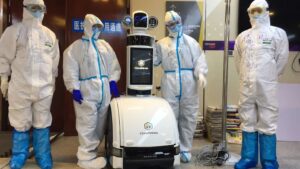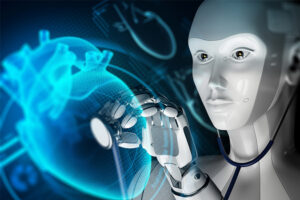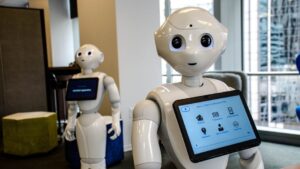Hello Bloggers, Welcome to all of you in Lifelong Health. In this article, we learn about Robotics in Healthcare. Throughout the world, operating rooms are gradually incorporating medical robots, which are revolutionizing the way surgeries are carried out. These cutting-edge devices can help surgeons carry out difficult and delicate procedures, helping to enhance results and lower the possibility of complications, expediting supply delivery and disinfection, and freeing up healthcare professionals to concentrate on interacting with and tending to patients. With more hospitals and clinics investing in these state-of-the-art technologies, the use of medical robots in surgery has increased recently. In this article we discuss about Robotics in Healthcare : Rise During Covid 19, Benefit, Concern & AI in Medical Robotics
Robotics’ ascent in surgical settings during COVID-19
Our world has changed, and the COVID-19 pandemic has affected many facets of our society. Every frontline employee has a significant risk, especially those who work directly with patients. Medical services have been severely curtailed, including the cancellation of elective surgeries, in an effort to prevent the spread of infections and safeguard patients and healthcare personnel. This has resulted in significant financial losses for numerous hospitals as well as a significant burden for the patients themselves. By physically separating the healthcare provider and patient, a robot can act as a shielding layer, effectively reducing the constant fear of pathogen contamination while maintaining surgical volume.
In this Perspective, we describe specific cases in pre-, intra-, and postoperative care where the application of robotics and AI can reduce the risk of infection and help with patient management in the operating room when there is a large number of patients. We also talk about the advantages of surgical robotic systems outside of pandemics and their cost-effectiveness. Hospitals are facing previously unheard-of demands as a result of the pandemic. In order to fight the virus, digitization and machine intelligence are becoming more important in healthcare. They could leave a lasting legacy that transforms surgical practice and management and outlives the pandemic.
Healthcare Robotics: Historical, Current, and Future
Hospitals are predicted to hold the largest market share in 2020, with the global medical robots market expected to reach $12.7 billion by 2025. Medical robots have advanced significantly in their ability to assist medical procedures and tasks since their modest beginnings in the 1980s. Around the world, innovators are building sophisticated capabilities for robotic systems in the healthcare industry and clearing the way for more accurate and effective treatment.
These days, robots are employed in clinical settings as well as operating rooms to assist medical staff and improve patient care. For the COVID-19 pandemic, for instance, hospitals and clinics are using robots for a much wider range of tasks to help reduce exposure to pathogens.
Robotics and automation are also utilized in research labs, where they are employed to automate labor-intensive, repetitive, and manual tasks. This allows scientists and technicians to concentrate on more strategic tasks that accelerate the rate of discovery.
Medical robotics’ streamlined processes and risk reduction are beneficial in a number of ways. Robots, for instance, are able to autonomously prepare and clean patient rooms, which helps reduce interpersonal contact in wards for infectious diseases. Hospital medication distribution and identification times are shortened by robots equipped with AI-enabled medicine identifier software.
Robots will operate with increasing autonomy as technologies advance, eventually handling some tasks completely by themselves. Consequently, healthcare professionals such as doctors and nurses will have more time to dedicate to providing direct care
Robotics’ advantages in healthcare
High-quality patient care, effective clinical procedure, and a secure environment for both patients and healthcare staff are all made possible by the use of Robotics in Healthcare .
1. Superb Patient Care
Intelligent therapeutics, frequent and tailored monitoring for patients with chronic diseases, minimally invasive procedures, and social engagement for senior patients are all made possible by medical robots. Furthermore, nurses and other caregivers can provide patients with more empathy and human interaction as robots reduce workloads, which can improve patients’ long-term wellbeing.
2. Clinical Workflows Simplified
Autonomous mobile robots, or AMRs, make repetitive tasks easier, lessen the physical strain on human labor, and guarantee more reliable processes. By maintaining inventory and placing orders on time, these robots can help ensure that supplies, equipment, and medication are available when needed, thereby mitigating staffing shortages and related issues. sanitization and cleansing Hospital rooms can be rapidly cleaned and prepared for new patients thanks to AMRs, freeing up staff members to concentrate on patient-centered and value-driven work.
3. A secure workplace
In hospitals where there is a risk of pathogen exposure, AMRs are used to transport supplies and linens in an effort to keep healthcare workers safe. Robots for cleaning and disinfection reduce hospital acquired infections (HAIs) by limiting pathogen exposure; hundreds of healthcare facilities currently use them1. AMRs, or social robots, assist healthcare workers by reducing physical strain by moving beds or patients and other heavy lifting tasks.
4. Robots for Surgical Assistance
Surgical assistance robots have improved in accuracy as motion control technologies have developed. With AI and computer vision capabilities, these robots enable surgeons to perform intricate procedures with unprecedented speed and precision. Surgeons could be able to supervise operations from a console as certain surgical robots can even perform tasks on their own.
Medical Robots: Some Concerns for Surgeons
Medical robots have many benefits for surgery, but there are drawbacks to their application as well. One problem is that these machines can be too expensive for certain hospitals and clinics to afford. The possibility of mistakes or malfunctions, which can be especially hazardous during surgical procedures, is another issue. But as technology advances, these issues will probably be resolved, making medical robots a more useful instrument in the operating room.
There are two primary types of surgeries carried out with robotic assistance:
- surgery involving minimal invasiveness on the torso. These consist of bariatric surgery, robotic prostatectomy, robotic hysterectomy, and other procedures mainly involving soft tissues. These robots insert themselves through a tiny incision and lock into position, providing a stable platform for remote surgical operations. Most internal procedures were previously performed through large incisions during open surgery. There was a much higher risk of infection and other complications, and recovery times were significantly longer. Even for a skilled surgeon, manually going through a button-sized incision is very challenging. The aim of surgical robots is to minimize infections and other complications by making these procedures precise and effortless.
- orthopaedic procedures. It is possible to preprogramme devices to carry out common orthopedic surgeries like hip and knee replacements. By utilizing spatially defined boundaries to support the surgeon, these robots enable more predictable outcomes by combining intelligent robotic arms, 3D imaging, and data analytics. Robots can be trained to perform specific orthopedic surgeries with precise guidance on where to go and how to perform the procedures thanks to AI modeling.
An Overview of AI in Medical Robotics : Robotics in Healthcare
The increased precision that AI brings to surgical operations is one of the most noticeable effects it has on medical robotics. AI-powered robots can help surgeons during procedures by analyzing vast amounts of data in real-time. They are able to perform fine incisions with sub-millimeter accuracy, provide extremely detailed images, and recommend the best surgical techniques based on patient data. The margin of error in surgical procedures is being greatly reduced by this degree of precision.
Surgical procedures can be extremely demanding, requiring intense focus for prolonged periods of time. No matter how experienced they are, human surgeons can become fatigued and make mistakes or, in the worst situations, perform less well. This is where AI’s revolutionary advantage in medical robotics is demonstrated.
One of the most interesting aspects of AI is its capacity for learning. This capability is a major game changer in medical robotics. These robots are always picking up new skills, refining their algorithms, and learning as they help with surgeries. For example, AI can assist in creating a surgical plan that is specifically customized to each patient’s anatomy and medical conditions after evaluating thousands of similar procedures. Adaptive planning could include tailoring a tumor’s removal strategy to the tumor’s dimensions, location, and proximity to important structures. Therefore, artificial intelligence (AI) in medical robotics is becoming more and more important in providing more individualized, patient-centered care.
Surgical expertise is becoming more widely available as AI-powered medical robotics become more widely available. With telepresence robots, surgeons can now operate on patients who are in a different city, nation, or even continent. These remotely controlled robots are incredibly accurate at replicating the surgeon’s movements in real time.
AI in medical robotics is expected to have a significant impact on medical education, especially on the education of aspiring surgeons. Surgical trainees can practice in a risk-free, simulated environment that closely resembles real-life operating conditions thanks to the integration of virtual reality and AI. By exposing trainees to a wide range of scenarios through customization, these simulations can quicken their learning curve and improve their skill set even before they enter an operating room. It is anticipated that these training approaches, which are very interactive and immersive, will greatly enhance the proficiency and self-assurance of the upcoming generation of surgeons.
There are challenges involved in integrating AI with medical robotics. It brings up significant ethical and regulatory issues that need to be carefully considered. Patient safety must always come first. One of the main issues with AI in medical robotics is data privacy. The question of who is accountable when something goes wrong—the robot, the surgeon, or the algorithm developer—becomes crucial because these robots are meant to learn and adapt.
Not with standing the enormous potential, there are a number of obstacles that must be overcome, such as the high expense of these systems, the requirement for personnel to receive intensive training, the possibility of malfunctions, and the danger of cyberattacks.
You may also Read : Best Home Remedies For Fever : Kid’s and Adults
Closing Remarks
To sum up, the emergence of surgical robots has brought about a noteworthy advancement in the healthcare industry. These devices provide a number of advantages, including decreased risk of complications, quicker recovery periods, and enhanced accuracy and patient outcomes. We anticipate seeing even more sophisticated medical robots hit the market as technology develops further, revolutionizing the way surgeries are carried out. I hope this article on Robotics in Healthcare : Rise During Covid 19, Benefit, Concern & AI in Medical Robotics help you all.





2 thoughts on “Robotics in Healthcare : Rise During Covid 19, Benefit, Concern & AI in Medical Robotics”